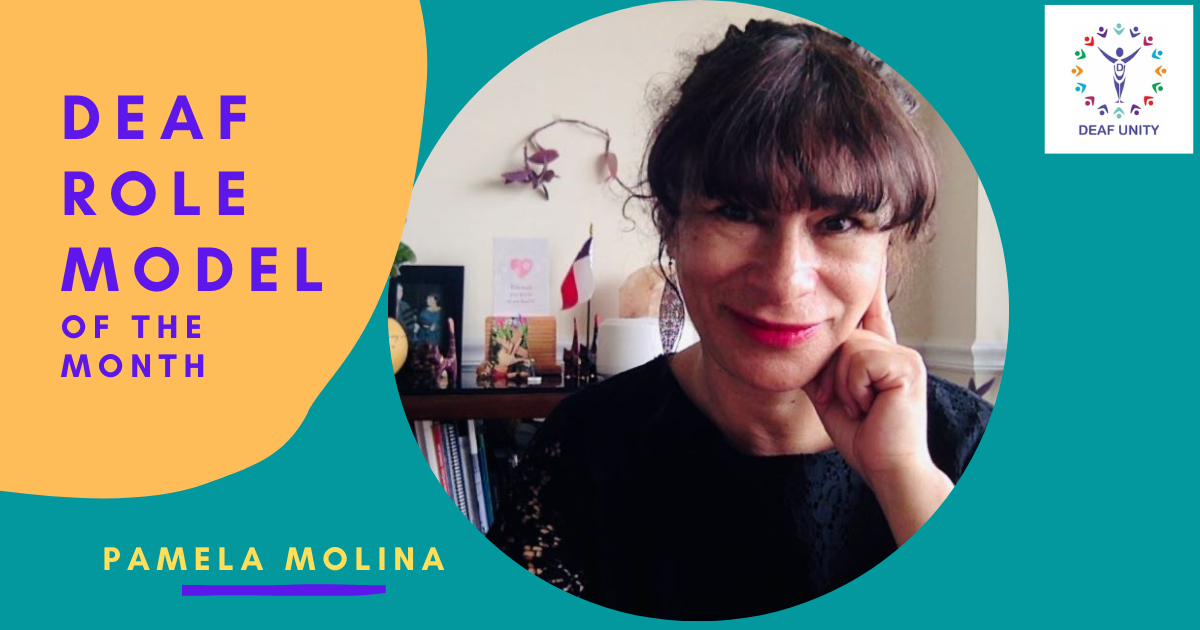 Each month we invite an inspirational or outstanding deaf role model to share their story. From what they’ve learnt, to what they wish they’d have known and their best deaf tips.
Each month we invite an inspirational or outstanding deaf role model to share their story. From what they’ve learnt, to what they wish they’d have known and their best deaf tips.
Our role model this month is Pamela Molina who currently serves as the Executive Director of the World Federation of the Deaf, supporting 132 National Associations of the Deaf members in 132 countries and managing the WFD Secretariat’s staff. Pamela has a long and varied history in deaf rights and advocacy and is someone that all of us can learn from! Enjoy!
1. Please tell us a little about yourself?
I am from Chile, South America. I was born hearing and became profoundly deaf at 13 years old. My BA is in Hispanic Literature and Humanities from the University of Chile. I also have a Master of Sciences in Disability Studies and Human Development from the University of Illinois at Chicago. I started my advocacy work in Chile, fighting for sign language inclusion on the TV news, a long time before the United Nations Convention recognized our sign language rights. I participated in the drafting of the United Nations Convention for the Rights of Persons with Disabilities and have over 15 years of experience in the international human rights field. I advocate for disability rights, linguistic rights and minorized groups’ rights. I am currently the Executive Director of the World Federation of the Deaf, since 2021 to date.
My mom still lives in Chile, and I don’t have any siblings. I am single and don’t have any children. I have many meaningful friendships and a cat. 🙂
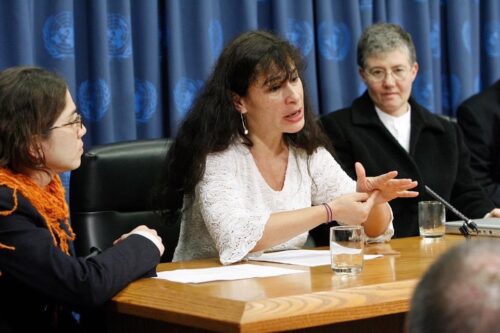
2. What is your deaf story?
It was an abrupt and colossal change, indeed. I started learning sign language at 19 years old. Before that, I saw myself as hearing people see us: with a “disadvantage”, as a “hearing impaired” woman who must demonstrate to everyone that I can do anything “despite” my deafness, that I can “adapt” to the hearing world, trying to live as if I was hearing. When I met the deaf community it was like an earthquake for me. My life changed then 180 degrees. I saw deaf pride. I saw deaf power. Thus, I realized I must learn sign language to communicate with my peers fully. I also discovered nothing to fix or missing in deaf people. I started my process to deaf hood. I entered the deaf community and never left. I became an advocate for sign language rights in Chile and was the President for four years of a Chilean association of the deaf. And yes, I consider myself now having a solid deaf identity.
3. What was your experience of education as a deaf person?
I became deaf at 13 years old, so I already had complete aural/oral language acquisition and development. I spoke orally in Spanish and could read and write in Spanish. Spanish is my native language. When I became deaf, there was no educational inclusion policy in Chile, and I had to adapt and assimilate into the mainstream school. There were no sign language interpreters, captions or any accessibility measures. I recorded the classes, and my parents later transcribed the audio for me. I also borrowed classmates’ notes to learn what was said in the classroom. That was my way to survive the school system as a deaf person. I experienced bullying in high school and was always alone. The breaks between classes were a nightmare; nobody wanted to be near me. At University, people were adults with more empathy and understanding. I gained beautiful and lifelong friendships from my University years. Some classmates offered to transcribe classes so, progressively, my parents could stop doing this job for me. I didn’t get any curricula flexibility or accessibility support in my school years.
When I moved to the USA for my Masters’ degree, it was a very different history.
4. You are the executive director of the WFD, what does your job entail?
I am primarily focused on operationalizing the Board’s decisions in any matters. We support our 132 National Associations of the Deaf members in 132 countries. I am also in charge of increasing the WFD budget through fundraising, grant proposals, and searching for donors. I also work on improving our partnership with other international organizations working on disability rights, deaf rights, disaster risk reduction and other matters related to human rights. I manage a team of 7 people, the WFD Secretariat’s staff. We are a small team ready to respond to global challenges that impact deaf people’s lives.
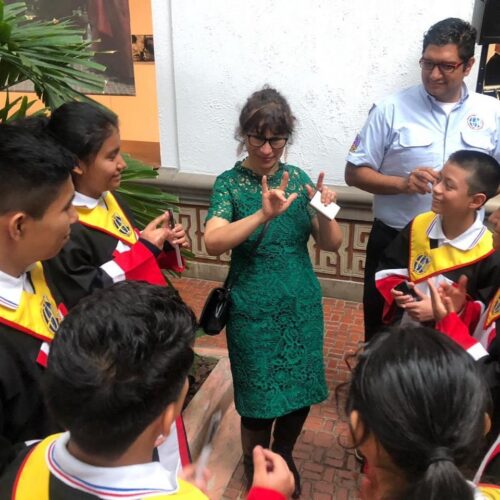
5. You have studied at three different universities, one in Chile and two in America, did you have a similar experience at all three?
As I said before, studying in the USA was a huge difference. When I arrived in Chicago, I was the first deaf international student at the University, who also didn’t speak in English orally. I didn’t know American Sign Language (ASL) when I first arrived in the USA; I only knew and used Chilean Sign Language. However, instead of all of this becoming my problem and my responsibility, the University staff acted with the full awareness that it was their problem and they must find a solution for me. Initially, they tried to give me several types of equipment to write in English and convert the words to voice, but I didn’t feel comfortable with it. They also provided me with CART services in the classroom, allowing me to get all that was being discussed.
CART was a massive discovery for me. If I had that service and technology in Chile, how easy studying would have been for me! It could have given me full autonomy in a Spanish environment. And my parents would not need to take time after their jobs to transcribe recorded audio. But there is still nothing like this in Chile or South America yet.
Nevertheless, I still needed a solution to participate and give an opinion or ask questions on an equal basis with others in my classes in Chicago. Thus, the University first hired a Chilean woman to come to classes with me and translate my questions or thoughts expressed in Spanish into English. However, this solution wasn’t the right one because the Chilean translator needed academic knowledge to appropriately translate some of my Spanish technical words. Thus, I finally took one year course on American Sign Language at the University of Chicago. My participation in the Chicago Latino Association of the Deaf reinforced my learning of ASL. I became involved with the Latino deaf community there, and ASL became my main communication channel. By the second year of my master’s studies, the University incorporated an American Sign Language interpreter for my classes, and everything was smooth from there on. I continued having CART services also. And all these resources were covered by the University. This kind of support with accessibility for my studies and my general autonomy in the USA have made a big difference in my life.
6. You do a lot of work in South American countries – are deaf rights improving there?
Yes. Almost all South American countries have signed and ratified the United Nations Convention on the Rights of Persons with Disabilities (UN-CRPD). They have made changes in their legislation to harmonize them with the Convention. Some countries have achieved legal recognition of their national sign languages, such as Chile, Colombia, Ecuador, and Mexico. Argentina and the Dominican Republic are fighting for it. Countries also have improved their policies for communication accessibility, and have included sign language interpreters in official messages, but there is still a lot to do.
These policies still need to be systemically implemented. And there is no clear protocol to prioritize deaf people and persons with disabilities in response to emergencies, such as COVID-19 or humanitarian conflicts. Access to education and employment in sign languages, justice, and health services are the biggest challenges in Latin America. In these areas, deaf children and deaf people experience structural gaps.
7. You sued the Chilean government for access and made a long lasting change, having sign language interpreters on TV – what was that experience like? Can you relate to the #WhereIsTheInterpreter campaign in this sense?
This experience was way before the UN-CRPD in the ’90s. Chile approved the first law on the “integration” of people with disabilities. I was, back then, the vice president of a national association of the deaf. A lawyer came to me and offered support to sue public TV channels under article 19 of the new law, under which the TV had an obligation to make accessible to deaf people daily news. The government provided a yearly budget for the TV to comply with this law. However, the law didn’t specify how they could make the information accessible, leaving it up to each channel company to decide. And they limited the “accessibility” to adding some “titles” to the news. I accepted the lawyer’s offering and called a general assembly of our association to decide how we would like the TV to comply with their obligation of providing access to the news for deaf people. Most of our members chose a dual method: Chilean sign language interpreters and closed captions simultaneously. But the lawyer pushed us to choose only one alternative as it would give us more chance of success. We discussed the point again and voted to advocate for Chilean Sign Language. Thus, I led a national movement for the linguistic and cultural rights of the Chilean Deaf Community in the years 2001-2002, where I had to face two main challenges: first, Deaf associations were divided, with conflicts of leadership, and unable to agree about what would be the significant common objectives as a community to fight for. Second, government authorities weren’t supportive of recognizing our Chilean Sign Language.
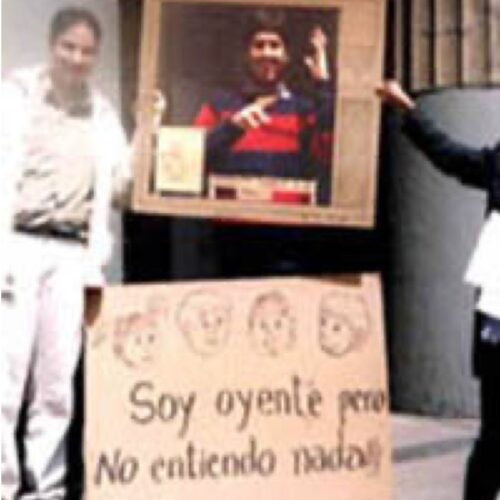
We sued the national television channels for not complying with the national disability rights law. The first court gave us a judgement and ordered the TV channel to include Sign Language Interpreters in all the TV news within 30 days. However, the TV companies didn’t accept this sentence. They went to the Supreme Court, which decided in their favour, saying that the examples of violations of rights we described in our presentation were outdated. But we had our rights violated every day! After this sentence from the Supreme Court, I called the media to a press conference with my lawyer. I said that we would go to the InterAmerican Court on Human Rights and would sue the Chilean government now for neglecting and omitting our human rights. The government called me to a meeting one week after the press conference. They asked for a negotiation with the public TV channels in that meeting. I accepted, and we had six months of negotiation with all tv channels. They requested an agreement to sign, but they wanted it signed by all the associations of the deaf in Chile. I spent my own money travelling throughout the country to get the unification of 24 Associations of the Deaf in Chile to demand the inclusion of Chilean Sign Language on the TV news. The outcome was the achievement, in the year 2002, of the inclusion of Sign Language Interpreters on TV news for the first time, not just in Chile but in the whole LAC region. The agreement signed with the TV companies remains active until today and doesn’t have a termination date.
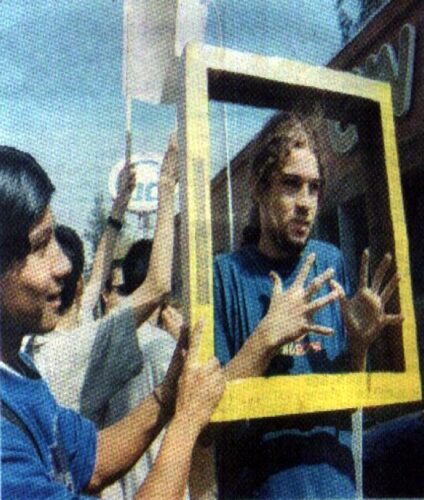
8. You were born and grew up in Chile before moving to America, how did you feel moving to a new country? Did it come with any new challenges?
Of course, it did! I didn’t know anyone in the USA when I moved, and the culture and language were very different from what I had known all my life. Besides learning a new way of life, I had to simultaneously face the challenge of studying for a Masters in another language. People in the USA are primarily individualists. In Latin America, there is still a sense of collaboration, and people are always willing to involve in your life and help. Here, if you don’t have money, you are stuck and alone. Also, people here aren’t used to hugging. I missed hugging! And Latin American culture is very relaxed about time. I had to learn to be on time and have lunch and dinner significantly earlier. I had to learn about social security and credit bureaus systems. These are just some examples.
9. You’ve done so much work in disability rights, do you feel like there is still a long way to go?
Yes. We have meaningful advances after the approval and ratification of the UN-CRPD, but there is still a long way to go to change stigma, stereotypes and attitudes. Structural changes are required to eliminate structural discrimination, including at cultural and symbolic levels. We will not see these changes, but I hope the next generation will.
10.Who inspires you and why?
Love inspires me. Jesus, Martin Luther King, Ghandi, Nelson Mandela, Rigoberta Menchu, Berta Cáceres, Hellen Keller. And within the disability movement, Judy Heumann, María Verónica Reina, Marilú Fernández, Tina Minkowitz… “All you need is love!” 🙂
11.What ways do you think hearing people can be allies to the deaf community? Any DOs and DON’Ts?
Hearing people can always be allies to the deaf community if they genuinely respect our identity and our diversity and learn sign language not to talk for us, not to speak on our behalf, but to talk WITH us, to get to know us, and get a comprehensive understanding of our way of being and stand in the world. An ally to our cause:
- Don’t speak for us
- Don’t try to ‘hearingsplain’ to us
- Don’t try to force us to adapt to the hearing way of being
- Don’t try “to help” us
An ally is a person that understands and is convinced that supporting our cause, our diverse and intersectional identity and our signing voices is a matter of freedom and justice. By supporting us, they are promoting their own liberation as human beings. An ally is a person that allows us to speak out the way we want and push for our leadership because all the oppressions are interlinked, and so is our liberation.
12. 3 top tips for deaf people?
Only one: continue talking with hearing people. If we want a world where deaf people everywhere can sign anywhere, they need to get to know us and learn and understand our culture, language and identity. They need to see us all around! Let’s give them that opportunity.
To read more inspirational role model interviews, take a look here. If you would like to be an ally to the deaf community and learn sign language, check out our courses here.
Looking for more support? We’ve made it our mission to improve the lives of deaf people everywhere. Check out Deaf Unity’s projects to find out what we can do for you. If you’d like to get in touch, contact us here.

